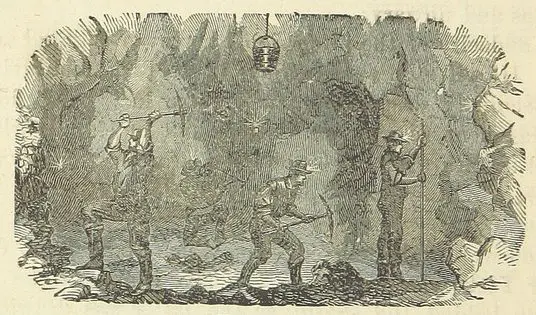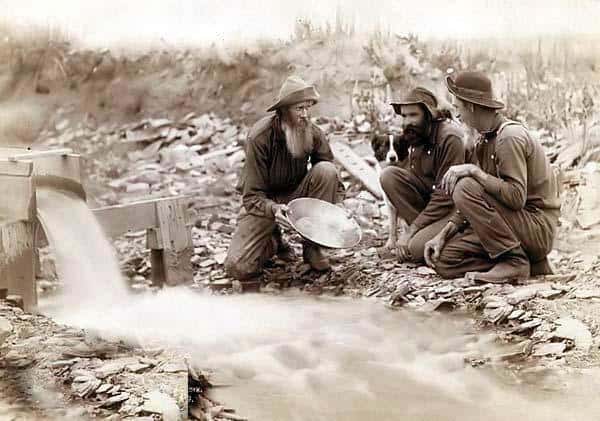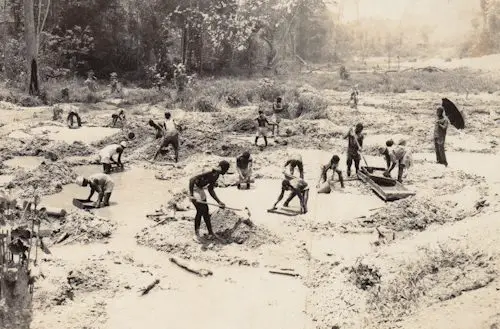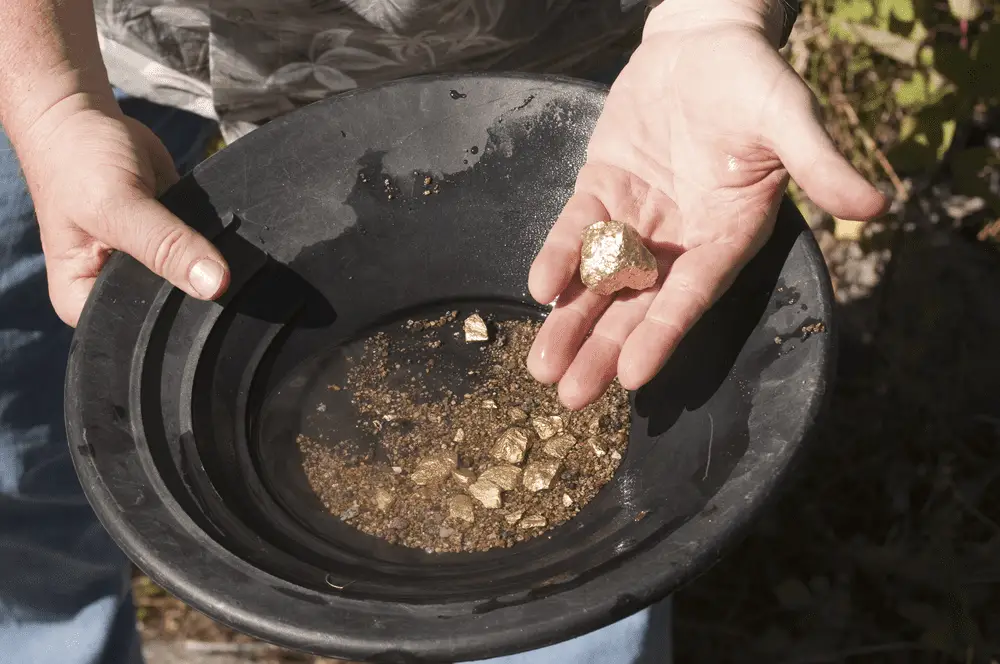Table of Contents
*This post may contain affiliate links. As an Amazon Associate we earn from qualifying purchases.
Found in Bulgaria are some of the oldest gold artifacts known to mankind, in the Varna Necropolis, a collection of graves built between 4700 and 4200 BC. This finding, dating back nearly 7000 years, provides evidence of the first civilization to use gold mining equipment.
Some archeologists claim the Sakdrisi site in southern Georgia, which dates to roughly 4000 BC, is the world’s first gold mine.
In the 19th century, gold rushes occurred around the globe and people migrated to different regions hoping to strike it rich. The Victorian Gold Rush took place in Victoria, Australia, between 1851 and the late 1860s, and the Second Boer War took place in South Africa between 1899 and 1902.
In America, the famous California Gold Rush took place in 1949, and discovery of Nevada’s Carlin Trend, North America’s largest gold depository, took place in 1961.
Since the beginning of civilization, humans have mined around 6 billions troy ounces of gold. Today, 2.5 percent of all gold production happens in Nevada, making it one of the primary regions on earth. As of recent years, China produced the most gold per year at 429 metric tons, followed by Australia, and then Russia.
However, there’s still a lot of gold out there, and you can join in the gold mining industry by investing in basic gold mining equipment. To see the most popular gold mining equipment currently available just click here.
Basics of Gold Mining

There are two basic steps to gold mining: prospecting and production. “Prospecting” refers to the actual search in a certain area for valuable minerals, and “production,” also known as mining, is the physical act of removing the gold from where you found it.
Since different equipment exists for prospecting and mining, this article explores, briefly, equipment used for prospecting, and then focuses, primarily, on gold mining equipment.
Go Where Men Have Gone Before
How do you find gold? In the gold mining industry, there’s a lot of value in learning from others who have gone before you. No one ever gets all the gold out of any one location. So, try going to where gold exists in abundance.
Consider this: the California Gold Rush only removed a small percentage of the gold that’s out there. That’s right.
There are areas in California that are still open to recreational prospecting, including the Auburn State Recreation Area and the South Yuba Recreation lands. Once you get your feet wet in an area proven to have gold, you can move on to other areas closer to home. After mastering prospecting and gold-mining techniques, you might even want to look for gold in your own back yard.
What Do I Look For?
Some people say, “Gold is where you find it.” What this means is you have to learn what to look for. First, understand that the way water moves in rivers and streams determines where gold deposits might settle.
Next, you need to learn why gold concentrates in certain areas, and then search those areas.
How to Read a Stream
Once you’ve selected a specific waterway for mining, you’ll want to pick specific points to search. Since it is impractical to search the entire stream or river, there are ways to “read” a waterway to determine the most likely places to find gold. The following describes how to find those places.
Gold Is Heavy
The first thing to know is gold is heavy. It’s about 19 times heavier than the same amount of water and 6 times heavier than solid material found in streams and rivers. So, anything that slows the movement of water is likely to trap gold deposits.
Things that slow down moving water are:
- Large rocks
- Trees
- Piles of debris
- Small islands
Water on the downriver side of obstacles will move slower, and this is where heavier gold will settle. When looking at a chosen waterway, begin by searching for natural dams where gold may have collected. Another place that collects heavier objects in a waterway is inside bends, places where water naturally slows down.
Heavy objects will often form a “bar” at these points, and the upside of a bar inside bends is a great place to look for gold.
Get Down to the Bedrock
Once gold has settled in a stream, over time, it works its way down layers of soil and settles in bedrock. A great location for gold is in the material coating bedrock under a stream.
Choose a location on the inside a bend where there is an obstruction and then dig to the bedrock. Sifting the soil coating bedrock, usually, will produce gold.
Patience Pays Off
Learn to delay the excitement of seeing gold for the first time and you will have more gold-filled dirt to take home with you. Once you get better at choosing locations, and especially if you find a proven location, it’s best to spend your time digging and removing dirt, rather than sifting and cleaning it on site.
Delay celebrating and get as much dirt as possible to take home. Once you get home, sift and clean the gold you’ve found.
Check the Grass
Another great place to look for gold is in tall grass growing above an inside bend. Grass acts like a sieve and the largest gold pieces end up at the roots of grass. They often call this kind of gold “oat gold.”
The pieces might be smaller than gold found in other places, but there could be a lot.
Get a Detector
If you want to invest a little in your endeavor, you can purchase a metal detector designed to find gold. This gold mining equipment can cut down on the time spend hunting, but a mid-level detector can cost anywhere from $100-$300.
Know the Rules
When considering getting involved in gold prospecting and mining, make sure you learn and follow the rules. There are certain places where prospecting is legal and others where it is not. Many prospecting clubs exist and joining one can help ensure you are following rules.
For examples, most sites require that you refill any holes you have dug, and that you do not destroy local plant life. Learn the rules before you head out with your gold mining equipment.
Gold Mining Equipment

Once you’ve finished prospecting and have a location where you know there is gold, you will need gold mining equipment. What you use will depend on the size of your operation. If you are working in the gold industry, you will have industrial gold mining equipment.
If you are mining on your own as a hobby, you’ll need smaller, personal gold mining equipment. Let’s look at both.
Industrial Mining Equipment
If you want to use industrial mining equipment, make sure you have the proper training. If working for a business, they should provide needed training. However, if you purchased industrial gold mining equipment for a personal claim, be certain you know what you are doing.
Safety should always come first.
Mining Drills
Miners use drills for underground mining to create access holes for descending underground, or to place explosive charges to bring material to the surface. The drill miners choose depends on how and what is being mined.
Blasting Tools
Blasting tools create an explosion to blast away chunks of material to access minerals. Blasting can also remove chunks of unwanted materials that are keeping other machines or people from getting to a seam of wanted materials.
In underground and open pit mines, miners use both drilling and blasting tools, often together. They use drills to place blasting tools at the right depth and in the right place.
Earth Movers
Earth-moving machines move around large amounts of materials. They might haul material after blasting, move other materials allowing access to seams of minerals, dig underground mines, or get down to the bedrock where minerals might exist.
Crushing Equipment
Crushing equipment moves materials around an underground mine. Miners use this equipment to keep the flow of materials going at an efficient rate, and to save money.
It is easier to remove crushed rocks rather than heavy chunks, so crushing equipment saves time and effort.
Other Tools and Systems
Other tools and systems available for industrial mining monitors and assists with the flow of material through the mine include:
- Weight feeders
- Elemental cross-belt analyzers
- Automatic sampling systems
- Flow measurements systems
Middle Ground Mining Equipment
If you want to put a little more money into your operation, but aren’t ready to become an industrial gold miner, what follows is a discussion of items you can purchase to up your odds.
Gold Sluice Box
A sluice box is a way to sift through raw material more quickly. Essentially, it’s automated panning. These machines used to be large and heavy in the early days of panning, but are now lightweight and easier to use.
If you’re serious about mining, they are worth checking out.
High Banker Sluice Box
A higher quality sluice box, high banker boxes have a water pump allowing more material to move through faster. These boxes recycle water so you don’t have to rely on water flow in the river.
They recover more gold than basic models.
Gold Mining Trommel
This is another step up from the sluice box. The trommel is a high-volume sorter. It processes lots of material before sifting it using a sluice box.
This is almost commercial level mining.
Personal Prospecting Gold Mining Equipment
If you aren’t going into the professional gold mining industry, but are looking for a hobby or a part-time job to bring in a little extra money, consider joining a mining club to help you once you begin your prospecting journey.
The club will help you learn about personal gold mining equipment, but, for now, let’s take a quick look at what you will need.
A Good Pan
There are lots of different sizes, colors, and options in gold pans. Essentially, a 14-inch plastic pan is the best size, by far. Color does not matter, however gold shows up better in black. Black sand shows up better in blue or green.
There are many new kinds of pans, but a basic pan with sharp, undercut riffles is all you need. Make sure the bottom of the pan is as wide as possible to catch more gold.
Small Storage Bottle
You will need a place to store the gold you find. All you need is a waterproof container you can close tightly, such as a 35mm film container. You can purchase containers on the internet, specifically made for holding gold.
Crevice or Sniping Tools
These “tools” are items to help clean out crevasses to get at the material that may contain gold. You will need a crowbar to open cracks in the bedrock, and your crevice “tool” could be:
- Paint brushes
- Tablespoons
- Garden Trowels
- Commercial crevice tools
Trowel, Pick and Shovel
The tool you will use depends on what’s needed for digging.
A Good Bucket
A 5-gallon bucket is usually adequate. Use it to organize and carry tools or to transport materials to your home. Purchase at a hardware store, or you might already have one in your home.
A Magnet
Good gold magnets that remove black sand are available for purchase online.
Snuffer Bottle or Tweezers
You need tools remove fine gold from water. Since you don’t want to lose any gold because it’s too small for your hands, use a snuffer bottle to suck it up, or tweezers to grab it.
The Gold Lab
The last thing to consider is investing in Gold Lab, a personal system that recovers gold from the concentrate you have refined. A good gold panner can get most of the gold from refined dirt, but a Gold Lab kit will allow you to further refine and recover 100% of your gold.
How to Pan for Gold

Once you have your equipment, it’s time to get in the river to pan for gold. This simple technique mimics what the river does naturally. You recover material, or dirt and place it in the pan, from a river location where you think there might be gold.
Then, you shake it in a left-to-right motion underwater to sweep away light materials while causing heavier materials to go to the bottom of the pan.
Repeat the process, leaving only the heaviest things, including gold and black sand. Following are the basic steps for panning:
Fill the Pan
Fill the pan about ¾ of the way to the top. Remove any larger rocks.
Choose a Spot
Pick a location where water is at least 6 inches deep and flowing fast enough to sweep away unwanted material. Choose a location with a dry place to sit while you are panning.
Go Under
Submerge the pan of material under the water.
Knead
Use your fingers to knead what’s in the pan to break it up and saturate it with water. Since you want everything broken down and suspended in water, keep the pan underwater while doing this.
Shake
Take the pan with the riffles on the far side and shake it, vigorously, left and right. This breaks up materials sending heavier items to the bottom. Do not slosh water out of the pan. If you need to, repeat the previous step and break up larger chunks again.
Remove Rocks
When larger rocks come to the surface, sweep them out of the pan. Make sure you remove only the top layer. Continue to do this until all medium-sized debris is out of the pan.
Shake It Down
Continue shaking the pan back and forth and keep removing the top layer of lighter materials until you are down to only the heaviest materials, such as coins, BBs, old bullets, buckshot, nails, garnets, black iron rocks and black sand.
You should now be able to see gold in the pan when shaking and tilting it forward slightly.
Get Magnetic
Use a magnet to remove black sand and other metal objects. Keep removing things until only gold remains. Remove the larger gold pieces and save any leftover concentrate. Let it sit for a while so you can recover any remaining pieces of gold that settle.
Conclusion

If you have enjoy the outdoors, and have just a little ambition, you can make a hobby out of gold prospecting and mining. All you need are basic tools that as your gold mining equipment and the willingness to do a little research.
Once you decide where to go, or join a mining club to help you find locations, pack up your tools and prospect. It may take practice at panning before you find anything, but once you do, you’ll love the feeling of satisfaction and discovery.
If you find you enjoy the hobby, invest in semi-professional gold mining equipment and see if you can up the amount you discover. Even if you only discover a few flakes, prospecting can be a great way to make new friends, learn about the gold industry, and understand a little about gold prospectors of old.
It’s an inexpensive hobby, so grab basic gold mining equipment and get started today.

